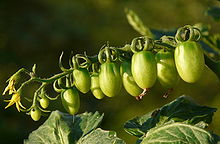Tomato
![]()
Paradeiser is a redirect to this article. For the Austrian composer and Benedictine monk, see Marian Paradeiser.
The tomato (Solanum lycopersicum), in parts of Austria and in South Tyrol also called the Paradeiser or the Paradeis (rarely Paradeisapfel), is a plant species of the nightshade family (Solanaceae). It is thus closely related to other edible plants such as the potato (Solanum tuberosum), the pepper (Capsicum) and the aubergine (Solanum melongena), but also to plants such as belladonna, mandrake, angel's trumpet, petunia or tobacco (Nicotiana).
Long called the candy apple, the apple of paradise or the golden apple (hence the Italian name "pomodoro"), it was not until the 19th century that it received its current common name, "tomato". This is derived from xītomatl, the word for this fruit in the Aztec language Nahuatl. Colloquially, it is mainly the red fruit used as a vegetable, which is a berry, that is called tomato. Former botanical names and synonyms: Lycopersicon esculentum, Solanum esculentum or Lycopersicon lycopersicum.

Views of the fruit and cross sections, here a ripe green variety
Description
Vegetative characteristics
The tomato plant is a herbaceous annual, biennial or occasionally perennial plant that initially grows upright, but later becomes prostrate and creeping. The individual branches can grow up to 4 m long. The stems are 10 to 14 mm in diameter at the base, green, with fine hairs and usually tomentose towards the tip. The pubescence consists of simple, unicellular trichomes up to 0.5 mm long, and sparsely distributed multicellular trichomes up to 3 mm long, usually consisting of up to ten cells. Especially the longer trichomes often have glandular tips, which give the plant a strong smell.
The sympodial units usually have three stem leaves, the internodes are 1 to 6 cm long, occasionally longer. The stem leaves are interruptedly pinnate, 20 to 35 cm (rarely only 10 cm or more than 35 cm) long and 7 to 10 cm (rarely only 3 cm or more than 10 cm) wide. They are sparsely hairy on both sides, the trichomes resembling those of the stems. The petiole is 1.2 to 6 cm long or occasionally longer.
The main stem leaves are in three or four (rarely five) pairs. They are ovate or elliptic in shape, the base is oblique and running towards the base of the whole leaf, truncate or cordate. The margins are toothed or notched, especially near the base, and rarely they are entire or deeply toothed or lobed. The apex of the subleaves is acute or acuminate. The uppermost leaflet is usually larger than the lateral leaflets, 3 to 5 cm long and 1.5 to 3 cm wide. The petiole is 0.5 to 1.5 cm long. The tip is usually pointed. The lateral subleaves are 2 to 4.5 cm long and 0.8 to 2.5 cm wide, attached to petioles 0.3 to 2 cm long.
The second-rank subleaves are mostly located on the side of the lower main subleaves facing the leaf tip. They are 0.2 to 0.8 cm long and 0.1 to 0.5 cm wide, they are sessile or stand on a stalk up to 0.4 cm long. Third-rank subleaves are absent. There are usually six to ten intercalary leaflets between the main leaflets. These are 0.1 to 0.8 cm long and 0.1 to 0.6 cm wide, on petioles 0.1 to 0.3 cm long. False stipules are not formed.
Inflorescences and flowers
The inflorescences grow up to 10 cm long, consist of five to fifteen flowers and are mostly undivided or rarely split into two branches. The inflorescence stem is shorter than 3 cm and hairy similar to the stems. The inflorescence pedicels are 1 to 1.2 cm long, and the outer third is jointed. The shape of the inflorescence is a coil.
The buds are 0.5 to 0.8 cm long and 0.2 to 0.3 cm wide and straight conical in shape. Before flowering, the corolla protrudes about halfway from the calyx. At flowering, the calyx tube is very fine and covered with calyx lobes up to 0.5 cm long. These are linear in shape, pointed towards the front and covered with long and short, simple, single-rowed trichomes. The bright yellow, pentagonal corolla is 1 to 2 cm in diameter, often banded and in some cultivated forms with more than five tips. The corolla tube is 0.2 to 0.4 cm long, the corolla lobes are 0.5 to 2 cm long, 0.3 to 0.5 cm wide, narrowly lanceolate in shape, and sparsely covered at the apex and margins with intertwined, single-rowed trichomes up to 0.5 mm long. At flowering time the corolla lobes are protruding.
The stamens are fused into a tube, this is 0.6 to 0.8 cm long and 0.2 to 0.3 (rarely up to 0.5) cm wide. It is narrowly conical in shape and straight. The filaments are very fine and only 0.5 mm long, the anthers are 0.4 to 0.5 cm long and have a sterile appendage at the tip that is 0.2 to 0.3 cm long and never more than half the total length of the anthers. The ovary is conical, with fine glandular hairs. The style is 0.6 to 1 cm long and measures less than 0.5 mm in diameter. It usually does not protrude beyond the stamen tube. The stigma is cephalic and green.
Fruits and seeds
The fruits are berries, usually measure 1.5 to 2.5 cm in diameter, but can also grow up to 10 cm in cultivated plants. Since the fruit is formed from two carpels, it has two chambers with numerous ovules. These are connected by a centrally located placental tissue. The number of carpels and thus of chambers can vary, mainly due to breeding. The fruit shape is usually approximately spherical, other growth forms such as oval-elongated or pear-shaped are also possible, also due to breeding.
The fruits ripen to a strong red, yellow or dark orange due to the carotenoid content and here in particular due to the lycopene, are initially hairy, but become hairy when ripe. The flower stalk has increased in length to 1 to 3 cm by the time the fruit ripens, and is often thickened in varieties with large fruits. It is straight or bent at the point of articulation towards the inflorescence axis. The calyx is also enlarged on the fruit, the calyx lobes are about 0.8 to 1 cm long and 0.2 to 0.25 mm wide and sometimes strongly bent backwards.
The fruits contain a large number of seeds. These are 2.5 to 3.3 mm long, 1.5 to 2.3 mm wide and 0.5 to 0.8 mm thick. They are inverted ovoid, pale brown and covered with hair-like outgrowths of the outer cells of the seed coat. These are either adpressed, giving the seeds a velvety surface, or shaggy. The seeds are narrowly winged at the apex (0.3-0.4 mm) and acuminate at the base. The seed coats consist in the outermost cell area of strongly slimy cylindrical epithelium, which is botanically called myxotesta. Between the individual seeds is a gelatinous tissue formed by the placenta.
Chromosome number
The chromosome number is 2n = 24.

Unripe tomatoes
.jpg)
Tomato Blossom
Systematics
Within the nightshades (Solanum), the tomato is classified in the subgenus Solanum and within this in the section of tomatoes (Solanum sect. Lycopersicon). Within this section, the species forms the Lycopersion group together with Solanum pimpinellifolium, Solanum cheesmaniae and Solanum galapagense, all of which produce red to orange fruits.
Various approaches have been taken to subdivide the species, especially since the 20th century, but none of them has been successful. Often, small, red and yellow fruits were called Solanum lycopersicum var. cerasiforme or Lycopersicon esculentum var. cerasiforme (colloquially often "cherry tomatoes"). It has been assumed that these correspond to the wild form of the species Solanum lycopersicum or are at least very close to it. However, they are probably cultivars and sometimes crosses with wild tomato species such as Solanum pimpinellifolium. These and all other varieties within the species are not recognized and are only listed as synonymous to Solanum lycopersicum.
Search within the encyclopedia